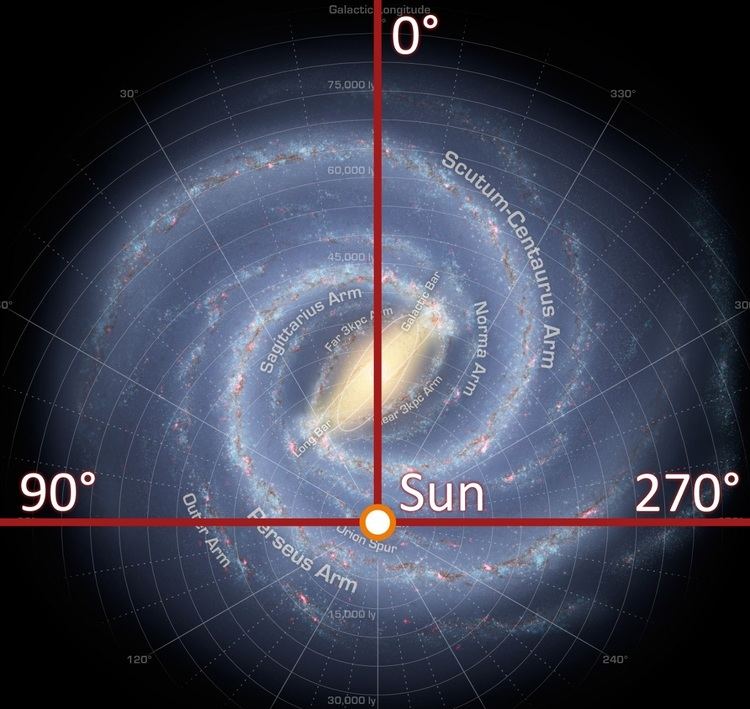 | ||
A galactic quadrant, or quadrant of the Galaxy, is one of four circular sectors in the division of the Milky Way Galaxy.
Contents
Quadrants in the galactic coordinate system
In actual astronomical practice, the delineation of the galactic quadrants is based upon the galactic coordinate system, which places the Sun as the pole of the mapping system. The Sun is used instead of the Galactic Center for practical reasons since all astronomical observations (by humans) to date have been based on Earth or within the solar system.
Delineation
Quadrants are described using ordinals—for example, "1st galactic quadrant" "second galactic quadrant," or "third quadrant of the Galaxy." Viewing from the north galactic pole with 0 degrees (°) as the ray that runs starting from the Sun and through the galactic center, the quadrants are as follow:
Visibility of each quadrant
Due to the orientation of the Earth with respect to the rest of the Galaxy, the 2nd galactic quadrant is primarily only visible from the northern hemisphere while the 4th galactic quadrant is mostly only visible from the southern hemisphere. Thus, it is usually more practical for amateur stargazers to use the celestial quadrants. Nonetheless, cooperating or international astronomical organizations are not so bound by the Earth's horizon.
Based on a view from Earth, one may look towards major constellations for a rough sense of where the borders of the quadrants are: (Note: by drawing a line through the following, one can also approximate the galactic equator.)
Traditional fourfold divisions of the skies
A long tradition of dividing the visible skies into four precedes the modern definitions of four galactic quadrants. Ancient Mesopotamian formulae spoke of "the four corners of the universe" and of "the heaven's four corners", and the Biblical Book of Jeremiah echoes this phraseology: "And upon Elam will I bring the four winds from the four quarters of heaven" (Jeremiah, 49:36). Astrology too uses quadrant systems to divide up its stars of interest. And the astronomy of the location of constellations sees each of the Northern and Southern celestial hemispheres divided into four quadrants.
Star Trek
"Galactic quadrants" within Star Trek are based around a meridian that runs from the center of the Galaxy through Earth's solar system, which is not unlike the system used by astronomers. However, rather than have the perpendicular axis run through the Sun, as is done in astronomy, the Star Trek version runs the axis through the galactic center. In that sense, the Star Trek quadrant system is less geocentric as a cartographical system than the standard. Also, rather than use ordinals, Star Trek designates them by the Greek letters Alpha, Beta, Gamma, and Delta.
The Canadian Galactic Plane Survey (CGPS) created a radio map of the Galaxy based on Star Trek's quadrants, joking that "the CGPS is primarily concerned with Cardassia, while the SGPS (Southern Galactic Plane Survey) focuses on Romulans."
